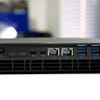Intel Hades Canyon NUC NUC8i7HVK: The Digital Foundry Verdict
A phenomenal first-gen product - but not quite powerful enough.
There's much to like about the NUC8i7HVK and the Intel/AMD Kaby Lake G offering in general. First of all, the sheer level of power integrated into such a small chassis is remarkable, and unlike other ultra small form-factor devices we've tested in the past, the NUC is a discreet machine that doesn't need to spin up its fans to the max while operating at peak levels of performance. The down side to this is that Intel allows the Core i7 8809G to hit some rather high temperatures under load - all cores and threads running at 3.9GHz sees temperatures gradually creep up to 90c and beyond. This is within spec, but a bit of a worry regardless.
For content creators, the opportunity to have a PC this small and this portable but with so much raw power is a great idea - in theory at least. It's let down a touch only by the fact now that gaming laptops have shifted onto six cores and 12 threads. It's unlikely that all cores will hit the same kind of frequencies seen here, but the increase in physical processors will take overall power up to another level. Given the choice between packing one of those new laptops for an E3 trip or this NUC, the laptop would get the nod. Where the NUC takes point is in its remarkable array of IO - the level of future-proofing in this regard is worthy of praise.
However, with the Radeon graphics onboard, it seems that the focus here really is all about the gaming - and what you are effectively getting is a fully integrated games machine with an enviable level of CPU power. Its graphics capabilities that are noticeably faster than a GTX 1050 Ti, but nowhere near as potent as the GTX 1060 or indeed AMD's impressive RX 570 and RX 580. The notion of this being a VR capable unit depends on the game of course, but the horsepower simply isn't here to hit the base specs set by Oculus back in the day - GTX 970 or R9 290 levels of power are significantly beyond this little machine. The recent reduction in VR spec from Oculus - which brings the NUC into play - is all about using timewarp to effectively bring minimum frame-rate spec from 90fps down to 45fps. It'll do the job, but it's not an optimal solution. On the plus side though, this is a full-blown AMD GPU, meaning that there's full support for everything in the Radeon ecosystem, including FreeSync, plus a (slightly) re-skinned version of AMD's excellent control panel - right down to overclocking via WattMan.
While the power level isn't quite where I'd want it to be, that's not to say that you won't get a great deal of performance out of this unit. And naturally, it is capable of running even the most challenging triple-A fare. You may not have the overhead of the mainstream GPU giants, but I happily played Battlefield 1 at 1080p on ultra settings at a super-smooth 60fps, which gives you some idea of what to expect here. Our benchmarks throughout this review are on ultra settings, and there will be many games that happily run at these settings, but on more taxing fare, resolution scaling and settings tweaks will see you claw back lots of performance - and the Core i7 8809G is certainly fast enough for running the vast majority of games at 60fps or higher.
The price of the NUC8i7HVK is certainly going to be unsettling for many, however. The NUC is typically provided as a barebones unit, with the user required to add in parts such as the SODIMM modules (and you're really going to need two of them for dual-channel bandwidth) and the M.2 SSDs. Once those costs are factored in, again, we're looking at prices comparable with GTX 1060-powered gaming laptops, which - as we've demonstrated - are significantly faster than the RX Vega technology here.
There's the sense overall that we're one generation away from this being the product that will really offer the full 1080p mainstream gaming PC in a truly small form factor. The key components are all there, but just not quite as powerful as the high price-point requires. For this sort of money, I'd be hoping for a six-core, 12-thread CPU and the move to 7nm fabrication technology on the AMD side would allow a smaller, cooler GPU to easily duke it out at the GTX 1060 and RX 580 level. However, Intel has to start somewhere, and as first efforts go, this is a really impressive little box - albeit one with somewhat niche appeal.
Intel Hades Canyon NUC8i7HVK Introduction
Hades Canyon vs GTX 1050 Ti/ GTX 1060/ RX 570/ RX 580
Hades Canyon vs Mobile GTX 1060/ GTX 1060 Max-Q Benchmarks


